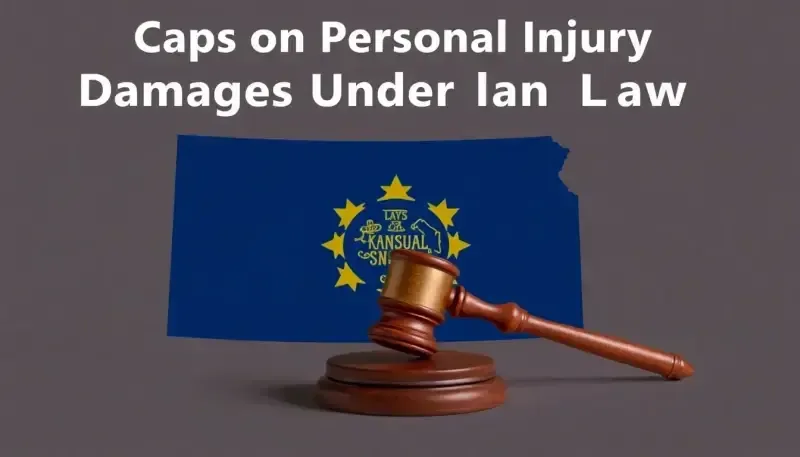In an unpredictable world, personal injuries can occur at any moment, often resulting from the negligence of others. This unfortunate reality can leave victims facing significant medical bills, lost wages, and emotional distress. While many may assume they are entitled to full compensation for their suffering, Kansas law imposes strict caps on personal injury damages, which can greatly affect the financial recovery available to victims. Understanding these limits is crucial for anyone navigating the aftermath of a personal injury.
Despite widespread criticism from legal experts and organizations like the American Bar Association, the caps on personal injury damages remain a reality in several states, including Kansas. To grasp the implications of these caps, it's essential to review the various forms of compensation that may be available to victims.
Understanding Personal Injury Damages
In Kansas, personal injury damages can typically be classified into two main categories: compensatory damages and punitive damages. Each serves a unique purpose in the context of personal injury claims.
- Compensatory damages: These are awarded to compensate the victim for both tangible and intangible losses resulting from the injury.
- Punitive damages: These serve as a financial punishment aimed at deterring the defendant’s egregious behavior and are not awarded in every case.
Compensatory Damages Explained
Compensatory damages aim to restore the victim, as much as possible, to their pre-injury state. They can be divided into two subcategories:
- Special damages: Also known as economic damages, these are quantifiable losses supported by evidence such as bills and pay stubs. They include:
- Loss of past, present, and future earnings
- Medical expenses directly linked to the injury
- Future medical care costs, including rehabilitation
- Expenses related to cancelled plans or trips due to the injury
- Repair or replacement costs for damaged property
- Funeral costs in the event of wrongful death
- General damages: These encompass non-economic damages which are more challenging to quantify. They include subjective losses such as:
- Pain and suffering
- Diminished quality of life
- Loss of companionship
- Mental anguish
- Long-term psychological effects
Caps on Personal Injury Claims in Kansas
Kansas law imposes strict statutory limits on non-economic damages, significantly impacting the total recovery amount for victims. The maximum compensation varies depending on the type of claim and the circumstances surrounding the injury.
General Compensatory Damages Limits
The following are the statutory limits for general compensatory damages, as outlined by Kansas law:
- For injuries occurring between July 1, 2014, and June 30, 2018: $300,000
- For injuries occurring between July 1, 2018, and June 30, 2022: $325,000
- For injuries occurring on or after July 1, 2022: $350,000
Punitive Damages Restrictions
Punitive damages in Kansas are capped as follows:
- The lesser of the defendant’s gross annual income for the five years prior to the incident.
- If a jury finds that a larger award is warranted, they may award half of the defendant’s net worth, $5 million, or five times the net compensation awarded to the plaintiff, whichever is greater.
- For corporate defendants, the award may be increased to 1.5 times the company's profit.
Limits on Wrongful Death Claims
In wrongful death cases, the compensation available is also capped:
- Compensation cannot exceed $250,000.
The Role of Comparative Fault in Kansas
Kansas operates under the modified comparative fault rule, meaning that the percentage of fault attributed to each party can impact the compensation awarded. Here’s how it works:
- If you are found to be 51% or more at fault for the incident, you are barred from recovering any damages.
- If you are less than 50% at fault, your compensation will be reduced by your percentage of fault. For example, if you are awarded $10,000 but found to be 20% at fault, you will receive $8,000.
The Impact of Damage Caps on Victims
Many victims in Kansas have become disillusioned with the legal process due to these damage caps. Often, they may feel compelled to accept lower settlements from insurance companies rather than pursuing their claims in court. This can lead to long-term financial repercussions that affect not only the injured party but their families as well.
It is crucial for victims to understand their rights and the true extent of their damages. Accepting a low settlement now can adversely impact one’s financial stability in the years to come. Seeking legal advice is vital to ensure that you pursue an equitable recovery.
Legal professionals, such as those at DeVaughn James Injury Lawyers, are equipped to help victims navigate the complexities of personal injury claims. They can provide expert testimony and build a strong case that reflects both economic and non-economic damages suffered.
For more information on the intricacies of personal injury law and the implications of damage caps, you can check out this informative video:
Understanding the laws surrounding personal injury claims in Kansas can empower victims to seek the compensation they deserve. Don't hesitate to contact a qualified attorney to discuss your case and explore your options for recovery. Remember, the right legal guidance can make a significant difference in the outcome of your claim.

